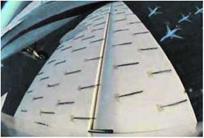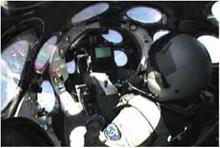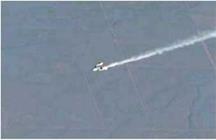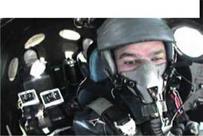A New Pilot Behind the Stick (8G)
Flying at 115 knots and 47,300 feet (14,420 meters), Pete Siebold detached from White Knight. Shown at the controls of SpaceShipOne in figure 7.10, Siebold became the second test pilot to fly SpaceShipOne. Mike Melvill had flown all the previous manned test flights.
Although SpaceShipOne’s performance was really starting to become dialed in, there was no shortage of work to do. Untested controls and the modified horizontal stabilizers needed evaluation— all this while Siebold learned how SpaceShipOne flew outside of the realm of the simulator. Figure 7.11 shows small strings attached to the horizontal stabilizer. With one free end, these strings helped the engineers identify how the air flowed over its surfaces.
Before Siebold completed the glide flight, he had to work on a new landing procedure that he and Binnie had been devising in order to improve reliability. “We had both very short, almost didn’t make it to the runway, and very long, almost off the end of the runway, landing excursions,” Doug Shane said.
Although SpaceShipOne glided okay, it didn’t have anywhere near the performance or control of a sailplane effortlessly gliding upward on the tops of thermals. The procedure involved overflying the runway and hitting altitude waypoints while being able to accommodate coming into the approach too high or too low. After 19 minutes and 55 seconds in the air, SpaceShipOne landed at the intended aim-point.
Flight Test Log Excerpt for 8G
Date: 14 November 2003
SpaceShipOne White Knight
Objective: The fifth glide flight of SpaceShipOne. New pilot checkout flight. Stability and control testing with the new extended horizontal tails. Tests included stall performance at aft limit CG and evaluation of the increased pitch and roll control authority. Other objectives included additional testing of the motor controller (MCS) and handling qualities in feathered flight.
(source: Mojave Aerospace Ventures LLC, provided courtesy of Scaled Composites)
|
|
 r >
r >
Fig. 7.11. During Pete Siebold’s first flight, he had to evaluate additional modifications to the horizontal
stabilizers put in place to rectify handling issues revealed two flights earlier. Small strings attached to the newly enlarged horizontal stabilizers were used to help analyze the air flow. Mojave Aerospace Ventures LLC, video capture provided courtesy of Discovery Channel and Vulcan Productions, Inc.
г-


 Fig. 7.12. Mike Melvill returned to the pilot’s seat for the ninth flight, which was the sixth glide flight of SpaceShipOne. In the photograph, Melvill pulls a handle to his left to deploy the feather for additional evaluation. Mojave Aerospace Ventures LLC, video capture provided courtesy of Discovery Channel and Vulcan Productions, Inc.
Fig. 7.12. Mike Melvill returned to the pilot’s seat for the ninth flight, which was the sixth glide flight of SpaceShipOne. In the photograph, Melvill pulls a handle to his left to deploy the feather for additional evaluation. Mojave Aerospace Ventures LLC, video capture provided courtesy of Discovery Channel and Vulcan Productions, Inc.
V______________________________________________________ ( ; ^
Fig. 7.13. An abort while fully fueled was a very big concern for Scaled Composites because
of the heavy weight for landing. Even when testing SpaceShipOne’s performance with ballast to more closely match the weight of a fully fueled rocket engine, it was necessary to dump the ballast prior to landing. Mojave Aerospace Ventures LLC, video capture provided courtesy of Discovery Channel and Vulcan Productions, Inc.
V_________________________________________________ J f
Fig. 7.14. Among the biggest surprises to Scaled Composites was the difficultly of landing SpaceShipOne without undershooting or overshooting the runway. The test pilot had to manage the airspeed and altitude very carefully on approach to the runway for landing. Mojave Aerospace Ventures LLC, video capture provided courtesy of Discovery Channel and Vulcan Productions, Inc.
|
|
Ґ
Flight Test Log Excerpt for 9G
Date: 19 November 2003
Flight Number Pilot/Flight Engineer
SpaceShipOne 9G Mike Melvill
White Knight 41L Brian Binnie/Cory Bird
Objective: The sixth glide flight of SpaceShipOne. Test pilot Mike Melvill’s first flight with the enlarged tails. Emergency aft CG handling qualities eval and simulated landing exercise with the new tail configuration. Airspeed and g envelope expansion and dynamic feather evaluation.
|
(source: Mojave Aerospace Ventures LLC, provided courtesy of Scaled Composites)
|











